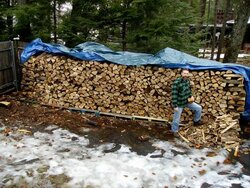I am still waiting on the Mansfield. It is scheduled to be installed next week and I am getting excited!! The wife says she is tired of being cold so make sure we have plenty of wood for it when it gets here  I have about 3.5 cords now ready and waiting to feed the beast. I am hoping this wil be enough to make it through the rest of the winter. I have a 1900 square foot cape. I have read that the newer stoves use about one third less wood then the old ones. Has that been the case for you mansfield owners ? Also could someone please explain to me what the secondary burn is. Is this a fire up in my burn tubes ? How do I achieve a secondary burn ? I am also wondering what the best log length is to use with this. The book says 21 or 22". Is that realistic ? I have 18 and 19"s now. Is it not good to have the wood leaning against the inside of the fire box or very close to it ? I seem to recall that on my old cast iron Timberline. Any Mansfield tips would be helpfull.
I have about 3.5 cords now ready and waiting to feed the beast. I am hoping this wil be enough to make it through the rest of the winter. I have a 1900 square foot cape. I have read that the newer stoves use about one third less wood then the old ones. Has that been the case for you mansfield owners ? Also could someone please explain to me what the secondary burn is. Is this a fire up in my burn tubes ? How do I achieve a secondary burn ? I am also wondering what the best log length is to use with this. The book says 21 or 22". Is that realistic ? I have 18 and 19"s now. Is it not good to have the wood leaning against the inside of the fire box or very close to it ? I seem to recall that on my old cast iron Timberline. Any Mansfield tips would be helpfull.
Thanks,
John
 I have about 3.5 cords now ready and waiting to feed the beast. I am hoping this wil be enough to make it through the rest of the winter. I have a 1900 square foot cape. I have read that the newer stoves use about one third less wood then the old ones. Has that been the case for you mansfield owners ? Also could someone please explain to me what the secondary burn is. Is this a fire up in my burn tubes ? How do I achieve a secondary burn ? I am also wondering what the best log length is to use with this. The book says 21 or 22". Is that realistic ? I have 18 and 19"s now. Is it not good to have the wood leaning against the inside of the fire box or very close to it ? I seem to recall that on my old cast iron Timberline. Any Mansfield tips would be helpfull.
I have about 3.5 cords now ready and waiting to feed the beast. I am hoping this wil be enough to make it through the rest of the winter. I have a 1900 square foot cape. I have read that the newer stoves use about one third less wood then the old ones. Has that been the case for you mansfield owners ? Also could someone please explain to me what the secondary burn is. Is this a fire up in my burn tubes ? How do I achieve a secondary burn ? I am also wondering what the best log length is to use with this. The book says 21 or 22". Is that realistic ? I have 18 and 19"s now. Is it not good to have the wood leaning against the inside of the fire box or very close to it ? I seem to recall that on my old cast iron Timberline. Any Mansfield tips would be helpfull.Thanks,
John


